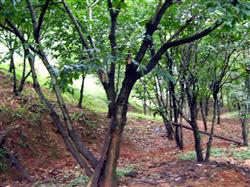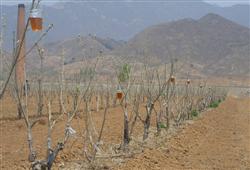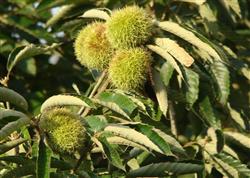How to manage Chinese chestnut in summer?

How to manage Chinese chestnut in summer? From July to August, the fruit development of Chinese chestnut is in the expansion stage. It is very important to do a good job in the application of strong fruit fertilizer, mid-tillage and weeding, pest control and summer pruning in time. Fertilizing and weeding and applying strong fruit fertilizer is the second topdressing for chestnut. In the first ten days of July, 15 kg of standard nitrogen fertilizer, 15-20 kg of phosphate fertilizer, 10 kg of potassium sulfate or 40-50 kg of special fertilizer for fruit trees were applied per mu. In addition, phosphorus and potassium fertilizer has an obvious effect on the development of chestnut fruit, which can be combined with 100 kg of plant ash in summer ploughing and ploughing, and weeds should be eradicated at the same time. In the first ten days of July, 1.8% avermectin biological agent 1500 times solution can be sprayed to control chestnut aphid and chestnut red spider, 50% phoxim 1000 times solution to control big bag moth, 2.5% enemy killing 2500 times solution to control chestnut gall wasp. The chestnut orchard with serious powdery mildew and branch blight can be sprayed with 1000 times of thiophanate methyl. In late August, 50% phoxim 1000-1500 times, Bacillus thuringiensis wettable powder 1000-1000 times or Yitaibao EC 1000-2000 times can be sprayed on the crown to control peach borer. Coring and thinning the first fruit tree should be carried out 1-2 times according to the growth of the branch, in order to delay the outward movement of the crown. The coring-treated branches can generally form 2-3 fruiting mother branches. The over-dense and slender branches should be removed in time at the semi-lignified or lignified place, which is conducive to the formation of more female flowers in the second year. Click to get more chestnut planting techniques click to get more fruit planting techniques
- Prev

How to manage young chestnut trees well
How to manage young chestnut trees? Please introduce the methods for young chestnut trees to be managed with reference to the following methods: 1. Management after grafting: after the scions of newly grafted young trees survive, they should first remove the sprouting tillers on the rootstock and concentrate all the nutrients on the new shoots; the high-grafted chestnut trees can retain some of them properly.
- Next

How to prevent the chestnut from being empty?
How to prevent the chestnut from being empty? What methods can be used to guide the empty bud of Chinese chestnut, also known as empty canopy, empty shell, fruit growers are called "dumb chestnuts". The empty bract rate of Chinese chestnut is generally about 15%, the high 80%, and some almost the whole plant empty bud. Therefore, preventing empty buds is the key to improve the yield and quality of Chinese chestnut. A reasonable choice.
Related
- Moge, come on! The staff of the peasant association in the producing area of cantaloupe were frightened when the crowd gathered.
- Causes and Solutions of low Fruit setting rate of Apple
- Symptoms and control measures of passion fruit virus disease
- Fruit growing lesson: how do apple orchards keep high yields?
- Can you build orchards in the mountains? What are the pros and cons?
- How to manage the coloring period of Crisson grape?
- This paper introduces the processing technology of two kinds of fig products.
- How much is a month for retired teachers in rural areas by 2020?
- How can strawberry planting increase sugar content? We should pay attention to management in many aspects.
- What are the cultivation techniques on how to improve the yield of golden fruit?

